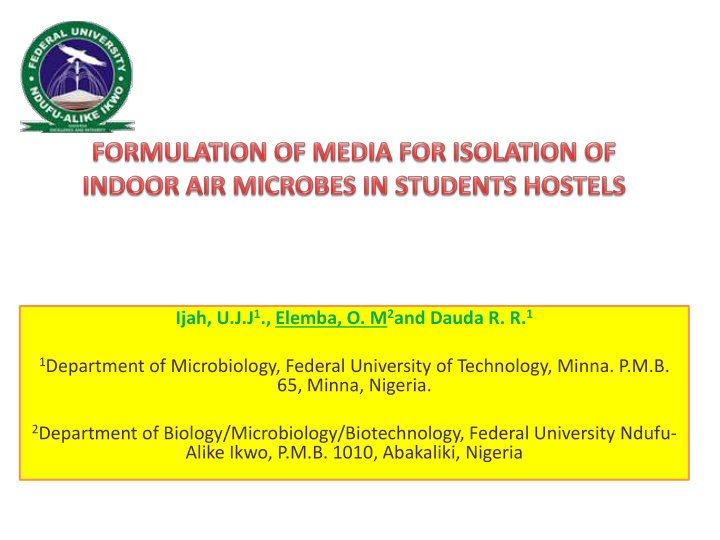



Ijah, U.J.J 1 ., Elemba, O. M 2 and Dauda R. R. 1 1 Department of Microbiology, Federal University of Technology, Minna. P.M.B. 65, Minna, Nigeria. 2 Department of Biology/Microbiology/Biotechnology, Federal University Ndufu- Alike Ikwo, P.M.B. 1010, Abakaliki, Nigeria
INTRODUCTION • There are no indigenous microbes in the air; microbes found in air are transported through wind and human activities, some of these organisms have been found to be harmful to the health of humans especially the pathogenic resident in indoor air (Yassin and Almouqatea, 2010). Therefore, there is a need to investigate the microbial quality of air in human environment (Hostel) and as well develop a selective medium that can help in the quick isolation of some of such indoor air microorganisms. AIM: The study was aimed at finding media (Henna incorporated nutrient and Sabouraud dextrose media) which will selectively isolate bacteria and fungi from indoor air in students’ hostels METHODS • Study area • Collections and processing of sample • Enumeration of Microorganisms • Characterization and Identification of Bacterial Isolates • Determination of effect of different concentration of henna on the growth of the microbial isolates. • Characterization and Identification of fungi isolates • Statistical Analysis •
0% 0.10% 7 1% BACTERIAL COUNT ( × 105CFU/ML3 6 5% 10% 5 20% 4 3 2 1 0 L M N O P Q HOSTELS/BLOCKS Figure 1: Population of bacteria present in HINA and NA
14 0% 0.10% FUNGAL COUNT( × 105CFU/ML3 12 1% 5% 10 10% 8 20% 6 4 2 0 L M N O P Q HOSTEL BLOCKS Figure 2: population of fungi from indoor air in the hostel
Percentage of occurrence KP SA 5% 5% 13% SE BS 3% 15% AN AF 17% P MM 7% 35% Figure 3: Frequency of Occurrence of Microbes in the indoor air from the hostel
Table 1: Bacteria and Fungi Isolates identified from Indoor Air in Student Hostel Concentration of henna in solid media (%) Organisms 0 0.1 1 5 10 20 Klebsiella pneumonia + + - - - - Staphylococcus aureus + + + - - - Staphylococcus epidermidis + + + - - - Bacillus subtilis + + + + - - Aspergillus niger + + + ++ ++ ++ Aspergillus fumigatus + + + + + + Penicillium spp. + + + + - - Mucor mucedo + + + + - - +positive growth, no growth
DISCUSSION The effect of varying concentrations of powdered henna leaves on the count of bacteria obtained from indoor air in hostel rooms as observed (Figure 1) revealed that the bacterial population decreased with increase in Henna concentration The frequency of occurrence of bacteria and fungi in indoor air in students’ hostels is shown in Figure 3. A total of 134 microbial isolates were obtained of which 47(35.07%) of the colonies were Bacillus subtilis showing the highest frequency of occurrence for bacteria while Aspergillus niger showed the highest frequency of occurrence 19(15%) for fungi. In varying concentrations of henna powder incorporated in Nutrient agar (NA) and Sabouraud dextrose agar (SDA) revealed that the extract of this plant had both antibacterial and antifungal properties which correlates with the studies of Rahmoun et al . , 2013; Rafat and Wagdi (2014). These results suggest that high concentration (20%) of Henna in solid media can selectively isolate A. niger and A. fumigatus ; while inhibiting the growth of other indoor air microorganisms.
CONCLUSION • From the result so far it was observed that Henna incorporated Sabround Dextrose Agar (HISDA) and HINA are good selective media for A. niger and B. substilis respectively; thereby reducing energy, laborious sub-culturing and cost of purchasing expensive complex media.
REFERENCES Yassin, M. F., Almouqatea, S. (2010). Assessment of airborne bacteria and fungi in an indoor and outdoor environment. International Journal of Environmental Science and Technology . 7 (3), 535-544. Rahmoun, R.M., Boucherit-Atmani, Z., Benabdallah, M., Boucherit, K., Villemin, D. and Noureddine, C. (2013). Antimicrobial activities of the henna extract and some synthetic naphthoquinones derivatives. American Journal of Medical and Biological Research. 1 (1): 16-22 Rafat K. & Wagdi S. S. (2014). Effect of henna and roselle extracts on pathogenic bacteria. Asian Pacific Journal of Tropical Disease , 4(4), 292-296. doi:10.1016/S2222-1808
Recommend
More recommend